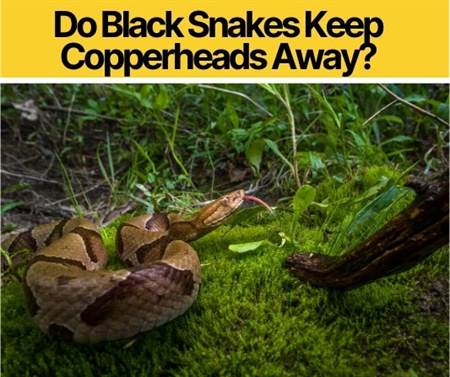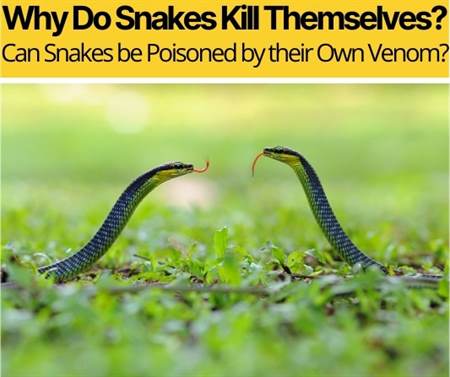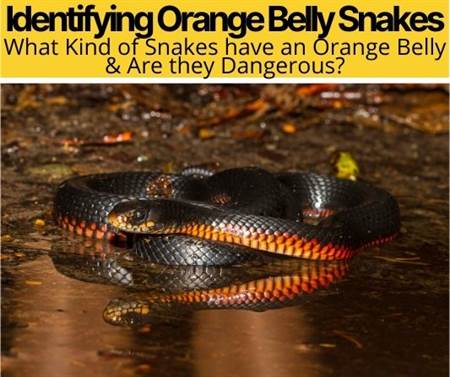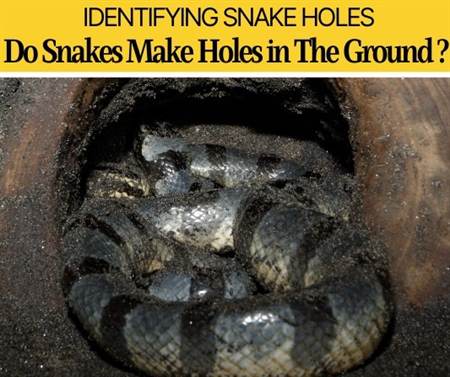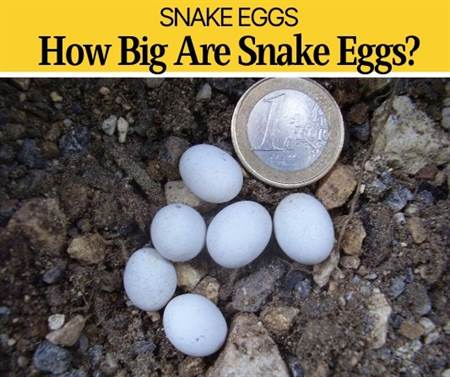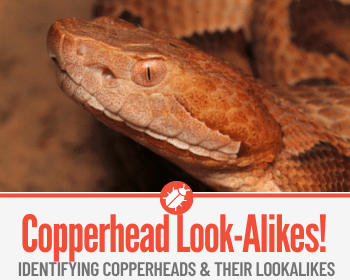 Did you just see a snake in your yard and have no idea what type of snake it is?
Did you just see a snake in your yard and have no idea what type of snake it is?
Are you afraid it might actually be a Venomous Copperhead and it could possibly come in contact with pets or your kids?
In this guide you will learn:
- What does A Copperhead Snake Look like & How to identify it,
- 10 of the most common snakes found in USA that might look similar to Copperheads,
- How to Tell these snakes apart from Copperheads & What to do if you get bitten by one!
While the Copperhead is venomous, it is actually only one of the five species of snakes that carry venom.
The majority of the species of snakes that you will come in contact with in your lifetime will be almost completely harmless.
Still, it is very important to learn about the ones that are venomous as well as the copperhead lookalikes that are harmless.
Below, you will also be able to find pictures of copperhead snakes as well as images of snakes that look like copperheads.
10 Of the Most Common Snakes that Look like Copperheads:
- Corn Snake
- Milk Snake
- Rat Snake
- Banded Water Snake
- Brown Snake
- Chicken Snake
- King Snake
- Eastern Hognose Snake
- Diamond Back Water Snake
- Rattle snake
What Does a Copperhead Snake Look Like
Most commonly seen in the Eastern United States, Copperhead snakes are normally found to be medium in size, or around 3 feet in length.
Copperhead snakes actually have quite a pretty design that ranges in different shades of browns and reds.
Each design wraps around its body and they normally make shapes that resemble hourglasses, or in some cases, people say they look like saddlebags.
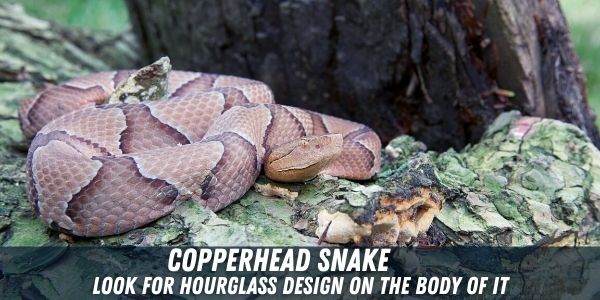
Interestingly enough, Copperhead snakes are the only species of snake that have these hourglass designs on their bodies. There are several other snakes that have similar colors to the Copperhead, but you should be able to tell them apart easily by seeing if they have the hourglass designs or not.
If they do not have the hourglass design, then it isn’t a copperhead!
The Copperhead’s belly is normally lighter in color, with the color usually being white or yellow.
On the sides of its belly, you will tend to find dark smudges or spots in a variety of different sizes.
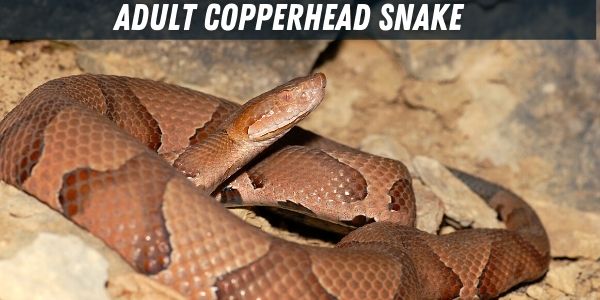
If you have found a Copperhead and are trying to determine the age, then all you have to do is look at what colors the snake has on its body. Younger Copperheads tend to be more grayish in color and they will have either a bright yellow or green tail tip.
This bright marking at the tip of their tails will actually fade away after about a year and the young Copperheads will slowly and gradually change color until they reach adulthood, which is around 3 years old.
Most Reliable Way to Identify A Copperhead Snake
As we have discussed above, the most common way to identify a Copperhead snake is by looking for the hourglass design along the length of its body.
Telling apart a female and a male is also quite easy. If the snake looks like it’s longer in length than others, then it is most likely a female. Males tend to not be quite as big in size compared to the females, although, they do normally have longer tails!
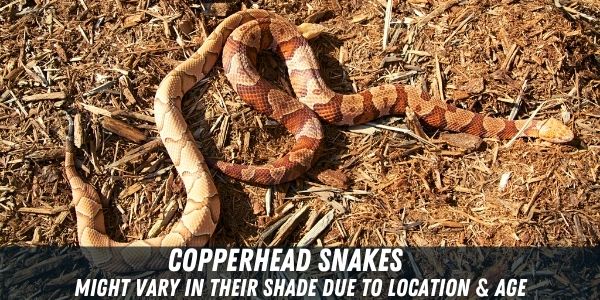
All Copperhead snakes tend to have thick, muscular bodies with ridged scales. Their heads might look triangular, and some have said they almost look “arrow-shaped”.
If you have ever looked at your cats eyes, you will notice that their pupils are vertical. You will notice this exact same characteristic in the Copperhead snake, and the irises will normally be a reddish-brown or tan color.
Sometimes they might even have an orange color to them.
Copperhead Lookalikes To Look out for
1.Corn Snake
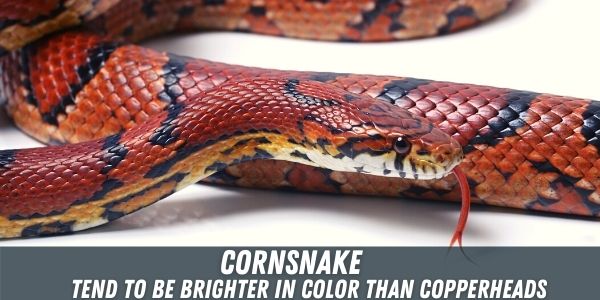
What snake gets mistaken for a copperhead more than any other? That would be the poor corn snake!
These harmless snakes often get killed because they were mistaken for a copperhead.
Corn snakes can be found in the Eastern and central United States, and you can usually find them in forest openings, overgrown fields, and even in uninhabited barns and houses.
These snakes actually do not carry any venom, so if you happen to be bitten by one, then you are in no immediate danger.
Although, snakes still tend to carry a lot of bacteria in their mouths, so make sure to clean and disinfect your bite well so it doesn’t get infected.
You can disinfect a corn snake bite by applying hydrogen peroxide or Neosporin directly to the area. Cover with a bandage or gauze and let it heal for the appropriate amount of time.
Corn Snake VS Copperhead
You can tell apart a corn snake from a Copperhead by looking at the colors and designs on its body.
Corn snakes tend to be brighter in color than Copperheads, showing more shades of red and a pale orange, while Copperheads usually look browner in color.
2.Milk Snake
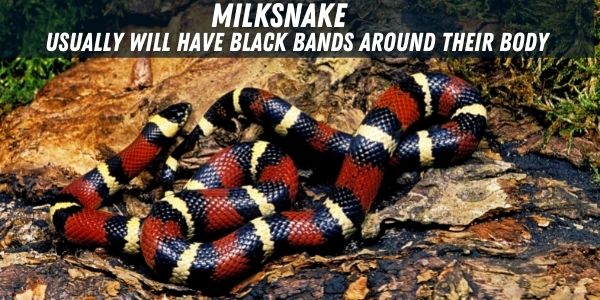
Milk snakes can mostly be found in Northeastern United States around Maine, Minnesota, Iowa, and even in the Southern states like Georgia and Alabama.
Milk snakes are among another species of snake that cause no harm to humans in any way. They do not carry venom and their teeth are so small, you can barely even see them.
If one does happen to bite you, which will usually only happen if you manage to pick one up, then it’ll produce nothing more than a small scratch.
Despite this, remember to clean and disinfect the bite well and put a bandage over it to prevent it from getting infected.
Milk Snake VS Copperhead
You can actually tell apart a milk snake from a Copperhead quite easily, and that is by looking at the colors and markings on the snake as well as its body shape.
Normally, milk snakes tend to grow longer than the Copperhead and they also have slimmer bodies as well while the Copperhead has a thicker, more muscular body.
Milk snakes normally come in the colors, red, black, and white, while Copperheads lack these designs.
These snakes will have black bands around their body with white and red on either side of it.
You can find milk snakes anywhere depending on which terrain they are inhabiting, but most commonly, they can be found in forested areas. You can even find them slithering along an open prairie occasionally too.
3.Rat Snake
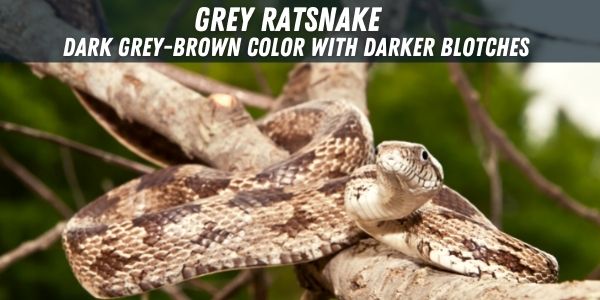
Rat snakes can also be quite easy to tell apart from Copperheads, but they will still occasionally be killed by someone who had mistaken them for a Copperhead, especially if it’s a grey ratsnake.,
This is a shame, because the rat snake is among the species of snake that are nonvenomous and pose no threat to humans.
Actually, they tend to help humans more than anything by eating any pests they may see, such as rats and mice.
If you happen to be bit by a rat snake, then the most that will happen is that you will feel pain around the area and you will also experience some swelling.
Treating the wound right away is very important, and seeing your local doctor about treatment would be a wise step to take as well.
As you can already tell, these snakes are pretty good to have around, especially since they don’t really have any need to come and bother us.
Rat Snake VS Copperhead
If you happen to see one and are not sure if it is actually a rat snake or a Copperhead, simply take a look at its color and remember that Copperheads normally come in shades of a reddish-brown color with a bit of tan.
If you happen to live up in north Alabama, then the rat snake in front of you will mostly likely come in a dark color, normally black or dark grey with a hint of white here and there between the scales.
If you live in south Alabama, then the snake will mostly appear to be a dark grey-brown color with dark blotches along its back.
For both of these snakes, you can distinguish them from a Copperhead by looking at how much darker the rat snakes are in comparison.
4.Banded Water Snake
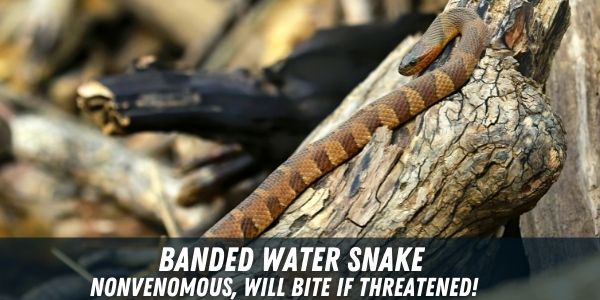
Another nonvenomous snake that tends to get mistaken for a Copperhead would be the Banded Water Snake.
These snakes can mostly be found in the Midwest and Southeastern United States.
Banded water snakes can grow fairly long, and they will tend to have heavy bodies.
They can actually come in a variety of colors, so there are some water snakes that will be mistaken for a Copperhead and some will not be.
Banded Water Snake VS Copperhead
Most commonly, the water snake will come in a light brown color, and other times, they will appear to be more red and black color with darker colored crossbones going around its body.
Normally, these water snakes can live peacefully besides humans and many other animals and will often quickly flee at any sign of trouble. Occasionally though, if they feel threatened, they will end up biting you as well as release a strong, musky odor.
5.Brown Snake (Found in USA)
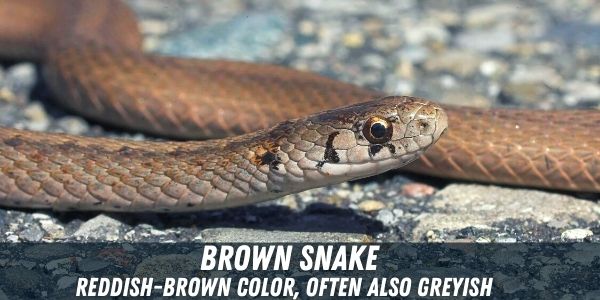
Similar to the snakes we have covered so far, the common brown snake is not venomous and they are completely harmless to humans.
They are a very shy and timid species of snake, and whenever they feel threatened, they will flatten their bodies in order to look bigger and threatening before releasing a musky fluid to drive you away.
However, if you happen to live in Australia or even Papau New Guinea, the species of brown snakes there are actually highly venomous, and you should take the proper precautious if you come in contact with one.
Brown Snake VS Copperhead
Similar to Copperheads, brown snakes will come in a reddish-brown color, and sometimes gray too. Although, unlike the Copperhead, they are smaller in size and they have thinner, slender bodies.
Unlike most snakes, the brown snake can most commonly be found near residential and urban areas. This gives them the nickname, “city snakes”.
If you live in an urban area, be mindful of areas with trash piles and construction materials, along with places that have a lot of flat rocks and loose stones.
These are some of the brown snake’s favorite hiding places, and they will spend the majority of their time hiding under this debris.
If you are bitten by a brown snake, immediately clean and disinfect the wound and wrap in a bandage or gauze. If it is necessary, see your local doctor if you think it could be infected.
6.Chicken Snakes
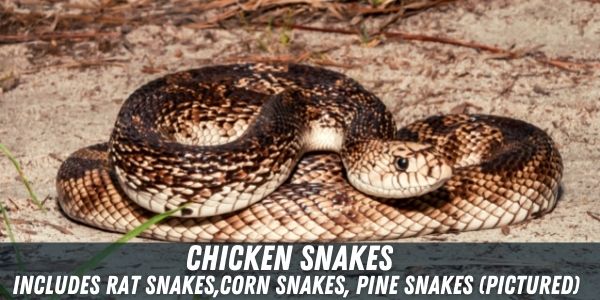
Something interesting about the “chicken snake” is that it’s not just one set species. The name is actually applies to several species of snakes that often like to feast on rats, eggs, and small birds like young chickens.
Snakes that fit into the “chicken snake” category are rat snakes, corn snakes, and pine snakes.
Chicken snakes are the nonvenomous species of snakes that are commonly found to be in the warmer, southern parts of the United States. Many people tend to mistake these harmless chicken snakes for the venomous Copperhead snake mostly because of the colors and patterns on their bodies.
If you have a chicken coop in your backyard, then you will probably find a chicken snake hanging around every now and then, waiting for its chance to get one of those delicious chicken eggs.
You will notice that chicken snakes have been helping themselves to your chicken yard if you see a decline in egg production, and if you notice that your chickens are slowly starting to disappear.
7.King Snake
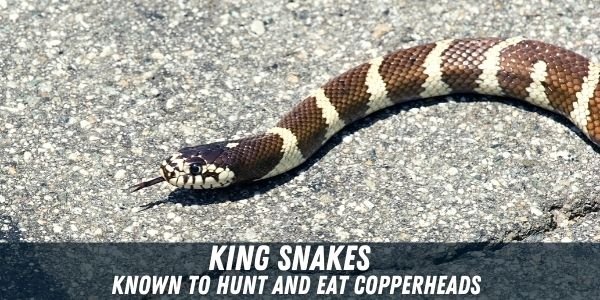
King snakes may sound scary, but they are actually a very beautiful and nonvenomous species compared . Unlike Copperheads, they don’t pose any threat to humans and they have no desire to harm us unless you make it feel threatened.
The most this snake will do when threatened is release a foil smelling musk from their anal gland. They will only bite as a last resort.
King Snake VS Copperhead Snake
To be able to identify a king snake and tell it apart from copperhead, look for the two distinctive colors on its body.
These colors are either a chocolate-brown or black with with yellow looking crossbands that repeat throughout the length of its body.
They normally grow to, at the largest, around 48in in length, and their dark scales will normally have a smooth and shiny look to them.
King snakes are actually quite docile when you tame them, so they can make great pets if you’re experienced at keeping reptiles.
Something interesting about this snake though are its strange eating habits. While they normally do eat rodents, frogs, lizards, small birds along with their eggs, they are also known to be cannibalistic.
Other than small reptiles, birds, and eggs, the king snake will also eat other snakes, along with venomous ones like the Copperhead.
8.Eastern Hognose Snake
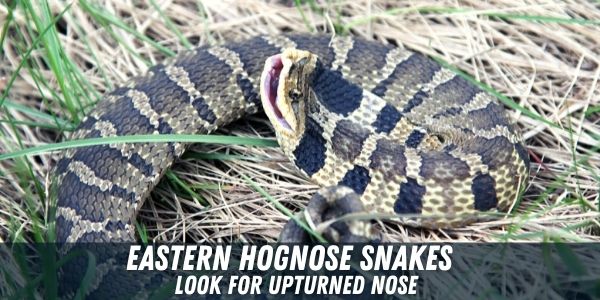
You can easily identify a hognose snake by looking at its nose. If you notice that the nose it upturned, then you are indeed looking at a hognose and not a copperhead.
Eastern Hognose snakes don’t get quite as long as a copperhead, and only grow to the length of about 46in.
Hognose snakes normally come in the colors yellow, brown, gray, green, or sometimes black, with large, dark spots going all the way down its spine. People have often called these designs on its body “eyespots”.
You will most commonly see these snakes slithering around in the daytime, usually around the spring and fall seasons.
Unlike the other species of snakes we have covered so far, this one is only mildly venomous. Biting is usually done as a last resort if they are feeling threatened by you.
First, they will suck in plenty of air to expand the skin around their head and neck so they can make themselves look bigger, similar to a cobra, before hissing and pretending to strike at you.
9.Diamond Back Water Snake
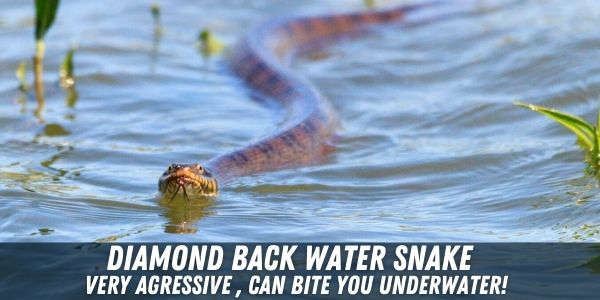
The diamond back water snake is one of the watersnake that can look like copperhead, can most commonly be found in in the central United States and northern Mexico, where the weather is normally hot.
Thankfully, this snakes is nonvenomous, but they are known for being pretty aggressive, and will not hesitate to bite if they’re being harassed or if they feel threatened.
They are also able to bite you while underwater, but only if they are being provoked.
Diamond Back Water Snake VS Copperhead Snake
These snakes can often be mistaken for the dangerous Copperhead snake because of its darker color and the designs all along its body.
If you look closely though, you will be able to tell that the designs on the water snake are different than the Copperhead’s.
This water snake can get a good bit bigger than a Copperhead, and can reach a length of around 48in. Although, the longest diamond back water snake has been said to be close to 60in.
Not only is the diamond back water snake bigger than the average Copperhead, they also have more of a grayish-brown color with the design of a dark chain going down the length of its body.
10.Rattlesnake
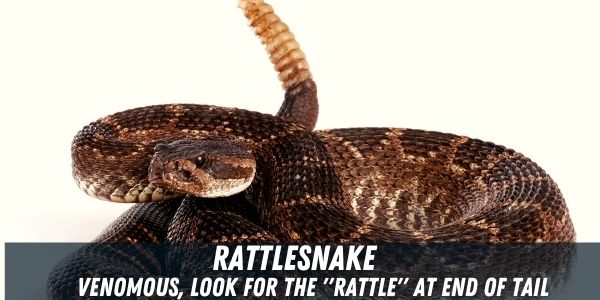
Rattlesnakes are one of the most iconic snakes of the United States, and it is mostly because of the “rattle” at the end of its tail. A rattlesnake will rattle this when they are feeling threatened, so it’s best if you back away calmly if you hear them emitting this noise.
The rattlesnake, as most people know, is among the species of venomous snakes, and you should always be incredibly careful if you find yourself face to face with one.
If you are bitten by a rattlesnake, the first thing you should do is call 911 and visit the Emergency Room. Keep the area that is bitten as still as possible, as venom can travel through the body faster when there is movement.
Remove constricting clothing to avoid swelling and refrain from walking as much as possible.
Many Emergency Rooms stock anti-venom drugs, and treatment can take anywhere from a few hours to several days, usually requiring hospitalization.
Rattlesnake VS Copperhead Snake
Rattlesnakes normally come in a variety of colors that range from dusty tan, gray, black, rust, and even cream colored on occasion.
Most rattlesnakes will have an easily identifiable pattern on their bodies that resemble blotches or diamonds.
Unlike the Copperhead, a rattlesnake will only grow to be about 12 to 26 inches in length, while a Copperhead can easily grow up to 36 inches.
Snakes That Look Like Copperheads In Your Area
The most common snakes that might look similar to Copperheads to an untrained eye will vary greatly depending on your location.
Below is a list of the states with one of the largest Snake Populations and the different species of snakes that might look Similar to Copperheads in these areas:
In Georgia
- Corn Snake
- Timber Rattlesnake
- Black Racer
- Brown Snake
- Northern Water Snake
- Gray Rat Snake
In Texas
- Garter Snake
- Cottonmouth
- Rattlesnake
- Hognose Snake
- Bull Snake
In Missouri
- Eastern Yellow-bellied Racer
- Great Planes Rat Snake
- Western Fox Snake
- Eastern Hognose Snake
- Plains Hognose Snake
In Kentucky
- Western Cottonmouth
- Timber Rattlesnake
- Prairie Kingsnake
- Milk Snake
- Corn Snake
In Virginia
- Black Racer
- Northern Water Snake
- Eastern Hognose Snake
- Mole Kingsnake
- Corn Snake
In Arkansas
- Cottonmouth
- Timber Rattlesnake
- Western Diamondback Rattlesnake
- Diamondback Water Snake
- Northern Water Snake
- Common Garter Snake
In Ohio
- Fox Snake
- Eastern Massasauga Snake
- Timber Rattlesnake
- Brown Snake
- Eastern Rat Snake
- Black Racer

